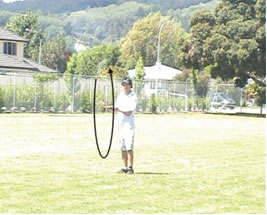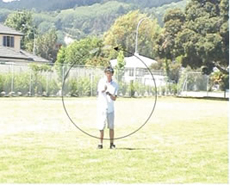Abstract
Video and audio analysis of a ‘Doppler ball’Â are used to study the Doppler effect quantitatively.


Principles Illustrated
As a sound source approaches or recedes, the frequency perceived by the observer increases or decreases. This is familiar with airplanes and cars and is used in a range of technologies. The frequency shift of the Doppler Ball is measured using sound analysis and video analysis software, and the results compared to Doppler formulas.
NCEA & Science Curriculum
PHYS 3.3
Instructions
In the standard Doppler Ball demonstration a ball containing a buzzer is swung in a circle or is tossed between students. Unfortunately the volume increases while the ball approaches and decreases while the ball recedes. This can reinforce the misconception that many students have that frequency is related to loudness. The Doppler Ball described here reduces changes in volume while the ball is swung in a circle by keeping the buzzer pointed in the same direction at all times during the motion.
This demonstration uses the following gear; a soft projectile(available from $2 shop or similar), piezoelectric speaker, 9V battery, switch, connecting wire(available from electronics suppliers), two fishing swivels, paperclips, rope for handles and a hot glue gun. Instructions for Making-the-doppler-ball. You will also need audio software capable for fourier transform(FFT) e.g. the freeware WavePad, available from http://www.nch.com.au/wavepad/ and most any video player that can step through a video frame by frame.
The radial velocity of the ball can be calculated from the video, counting the number of revolutions over a time period and measuring the length of the rope used on the ball. You’ll need to know the number of frames per second in your video, likely to be 25 frames per second (0.040 seconds per frame). You can then calculate the expected frequency shift from
 Video
Video
Download video (right-click and “save as”): Dopplerball.m4v
Download sound file (right-click and “save as”): DopplerBall.wav
In the video there are 25 frames per second and the string length is 0.9 metre.
 The Doppler Ball is not moving toward nor away from the observer and no change in frequency is heard. The buzzer points toward the observer throughout the motion thus minimizing changes in volume that distract students.
The Doppler Ball is not moving toward nor away from the observer and no change in frequency is heard. The buzzer points toward the observer throughout the motion thus minimizing changes in volume that distract students.
 The Doppler Ball is moving toward and away from the observer and a change in frequency is heard. The buzzer points toward the left throughout the motion thus minimizing changes in volume that distract students.
The Doppler Ball is moving toward and away from the observer and a change in frequency is heard. The buzzer points toward the left throughout the motion thus minimizing changes in volume that distract students.
Data
Click here for an extensive data analysis by Rory O’Keeffe.
Safety
Individual teachers are responsible for safety in their own classes. Even familiar demonstrations should be practised and safety-checked by individual teachers before they are used in a classroom.
Notes
The Doppler Effect is named after the Austrian, Christian Doppler, who discovered this effect. Today the Doppler effect finds application in a range of technologies including medical ultrasound, speed detection and astronomy.
Related Resources
Doppler ball qualitative
Teaching Resources
Would you like to contribute lesson suggestions? Contact us.
Credits
Earlier work on this demonstration including a functioning model was completed by Victoria University student Kenese Lautusi as part of a summer internship though the Awhina program.
This teaching resource was developed in collaboration with Rory O’Keeffe, a New Zealand Science, Mathematics and Technology Teacher Fellow, 2007, hosted by Victoria University School of Chemical and Physical Sciences. Rory is a science teacher by training and is currently Deputy Principal at Lytton High School in Gisborne, New Zealand. He is also an amateur astronomer. See www.rsnz.org/awards/teacher_fellowships for more information about the Teacher Fellow Program.
Lytton High School students Ash King, William Shields and Sean Besseling participated in the development of this resource.
This teaching resource was developed with support from
The MacDiarmid Institute
Faculty of Science, Victoria University of Wellington
School of Chemical and Physical Sciences, Victoria University of Wellington